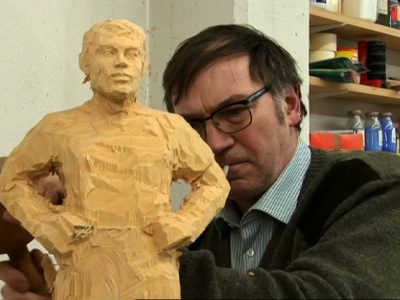Stephan Balkenhol
A film by Alyssa Verbizh
Production: Image & Compagnie / Arte, 2011
Duration : 26 mn
Stephan Balkenhol is an internationally renowned German artist, born in 1957 in Fritzlar. He has been concentrating on the human figure over two decades and began his sculptural process of figurative wood carving in the mid-Eighties – as a response to the abstract, minimalist and conceptual approaches of the Hamburg school of Fine Arts where he studied from 1976 to 1982.
The film offers a glimpse inside the artist studio and shows him at work, using a hammer and chisel to gouge some figures out of the tree trunk, leaving the shavings and traces of the tools visible in the wood with its knots, grain ans cracks.
We follow him from Karlsruhe where he teaches at the Kunstakademie to Meisenthal in France where he also lives and works. An Interview with Guy Tosatto, Director of the Grenoble Museum, reveals the artist’s complex relationship with figurative art and German History on the occasion of a large retrospective of his work.
Stephan Balkenhol est né en 1957 à Fritzlar en Allemagne. Depuis les années 80, privilégiant un bois tendre facile à travailler, il représente des hommes et des femmes d’aujourd’hui dans des poses simples en pied ou en portrait, comme une réponse à l’approche conceptuelle et minimaliste qui prévalait lors de ses années d’études à l’École des Beaux-Arts de Hamburg, entre 1976 et 1982. Ses sculptures sont sommairement exécutées à partir d’un bloc de bois laissant apparaître les imperfections, les fissures, les nœuds du bois.
Le film le montre au travail dans son l’atelier et révèle la grande concentration et la précision de l’artiste qui taille ses motifs d’un seul tenant, qu’il s’agisse de sculptures ou de reliefs. On le suit ensuite de la Kunstakademie de Karlsruhe où il enseigne, à Meisenthal en France où il a également un atelier. À l’occasion d’une grande rétrospective de son œuvre au Musée de Grenoble, un entretien avec son directeur Guy Tosatto, met l’accent sur la relation complexe qu’entretient l’artiste avec la tradition figurative et l’histoire allemande.
